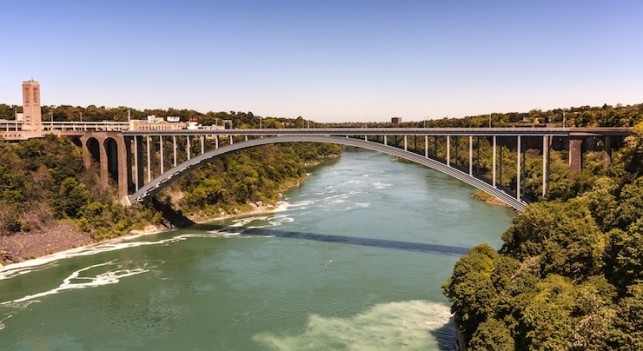The Niagara River has come a long way since the 1980s. One would still be advised not to drink the water, swim in some of the public beaches or eat the fish you reel in, but the latest report on the remediation plan reveals a river recovering from decades of abuse.
To mark the 25th anniversary of the Niagara River Remedial Action Plan, first agreed to in 1987, a report from Niagara College engineering professor Anne Michaud outlines the steps taken to improve the river on both sides of the border.
The Niagara River has come a long way since the 1980s. One would still be advised not to drink the water, swim in some of the public beaches or eat the fish you reel in, but the latest report on the remediation plan reveals a river recovering from decades of abuse.
To mark the 25th anniversary of the Niagara River Remedial Action Plan, first agreed to in 1987, a report from Niagara College engineering professor Anne Michaud outlines the steps taken to improve the river on both sides of the border.
The action plan consists of two separate but connected strategies from the Ontario and New York State governments to clean up the heavily polluted river.
And the results have been impressive. Despite the cautions listed above, since 1987, there has been a 99 per cent reduction in 18 pollutants discharged from Ontario municipal and industrial sources into the river that accounts for 83 per cent of the water flowing into Lake Ontario and supplies millions in the province with drinking water.
The problem of heavy industrial pollutants discharged into the river dates back to the early 20th century when industry and governments saw an opportunity to take advantage of hydroelectricity generated from Niagara Falls. By the time the Great Lakes Water Quality Agreement was first signed in 1972, signaling the importance of designing a bi-national response to water quality concerns in the lakes, there were more than 700 chemical plants, steel mills, oil refineries and other manufacturers dumping over 250 million gallons of wastewater into the river.
And despite an average flow rate of 5,700 cubic metres per second, 250 million gallons daily is an incredible amount of wastewater for one river to handle, let alone one supplying water to millions of people in the Great Lake states and provinces.
“These discharges have resulted in the current legacy of ecological problems that continue to face the river” more than a century after industry boomed in the area at the turn of the 20th century, Michaud said in the report.
“While pollutant concentrations in the Niagara River have declined steadily in recent years, the complete removal of pollutants from the surrounding ecosystem will require many more years to achieve,” she said.
Despite the Water Quality Agreement put in place in 1972, it wasn’t until 1987 when revisions were made to the agreement that the development and implementation of Remedial Action Plans (RAPs) were settled on as a way to restore ecosystem health with support from industry, conservation agencies, state/provincial/federal governments and the International Joint Commission (IJC).
The IJC helped establish 43 Areas of Concern (nine in Canada, 25 in the United States and 5 of common concern) within the Great Lakes Basin as locations requiring concise action plans to cleanup the designated waterways.
Tellingly, a map of the Areas of Concern (AOCs) shows a Great Lakes ecosystem where no corner is without significant stresses requiring a coordinated and lengthy remediation process.
Some AOCs include:
- Thunder Bay;
- Toronto and Region;
- St. Marys River;
- Bay of Quinte;
- Detroit River;
- Kalamazoo River; and
- Saginaw Bay.
All Remedial Action Plans work on a long-term basis, outlining remediation targets in three stages. Once all stages have been completed the watershed can be delisted by the IJC, though ongoing monitoring efforts usually continue to ensure the waterway stays healthy.
In Ontario, this effort is led by Environment Canada and the Ontario Ministry of the Environment, though regional agencies will step up to assist if an Area of Concern is in their jurisdiction. In Niagara, for example, the Niagara Peninsula Conservation Authority has assisted the provincial and federal governments in the cleanup effort.
Yet the public has a role in improving the Niagara River and all other AOCs in Ontario.
“It’s important to note that the RAP process is a collaborative, consensus-building process involving many participants, and includes extensive consultation with the public during all stages of its development,” Michaud said.
The Niagara River isn’t the only AOC to show signs of improvement. Environment Canada notes that, of the original 43 Areas of Concern, four have already been delisted for meeting their targets, including Collingwood Harbour, Severn Sound and Wheatley Harbour in Ontario and Oswego River in the United States.
But despite the tremendous success seen in the Niagara River, this is not a short-term exercise.
“Achieving a complete environmental clean-up and meeting all restoration targets in the short term will not be possible,” Michaud said in the report. “However, the overall health of the Niagara River continues to improve with every success that is achieved through the RAP.”
The work being done on the Niagara River is expected to wrap up in 2015 when Michaud hopes the site will be delisted and ongoing monitoring will be all that’s needed.
“But we can’t be complacent,” Michaud said. “There is more work to be done.”
The Current Events blog focuses on a wide array of environmental current events in Canada, ranging from issues of politics and public policy to energy, natural resources, and environmental science.
Andrew is a freelance environmental writer and reporter based in Toronto with a Masters in Geography from the University of Toronto. When he’s not writing he’s usually cycling around town, thinking about what to write next. Andrew’s posts appear weekly on Thursdays. You can read more of Andrew’s stuff at his own blog, The Reeves Report, or follow him on Twitter.
Andrew Reeves is the Editor-in-Chief of Alternatives Journal. Overrun, his book about Asian carp in North America, will be published in Spring 2019 by ECW Press. His work has also appeared in the Globe & Mail, Spacing and Corporate Knights. Follow him on Twitter.













